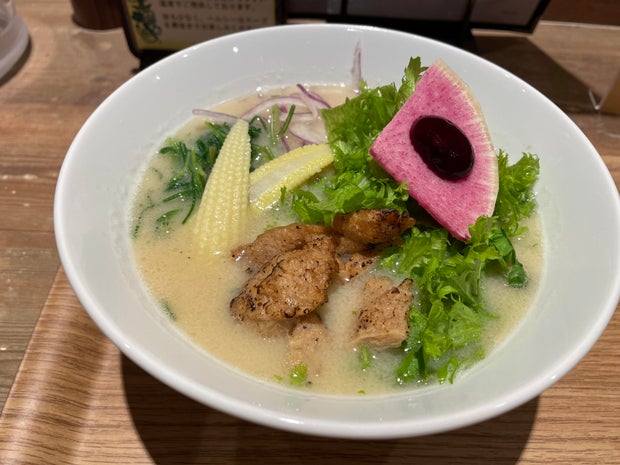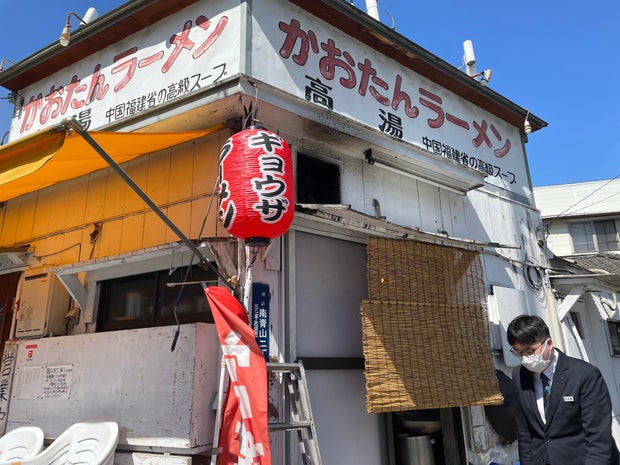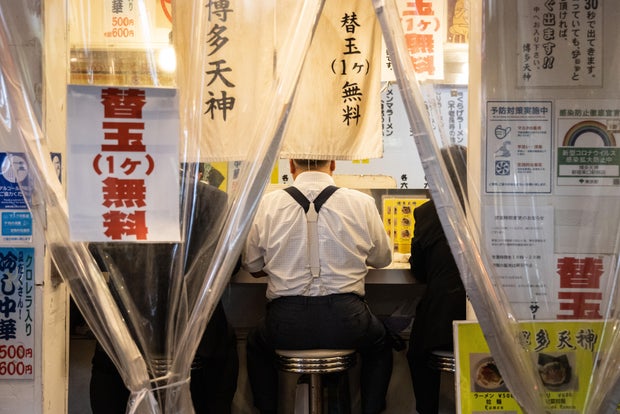[ad_1]
Tokyo — Japan’s ubiquitous ramen shops have long served that most-proletarian of dishes at no-frills counters, where customers unceremoniously slurp and gulp their way through boiling-hot bowls of noodles.
But while the ramen joints were long an almost exclusively male domain, the cement-floored greasy spoons of yore are giving way to hip décor, handcrafted crockery, and — hang onto your chopsticks — fusion flavors. And women are lining up.
Rise of the “Ramen Girls”
The English-language edition of Japan’s Nikkei daily recently noted a “new culture of ‘girl ramen'” sweeping the culinary landscape.
In the article, cultural commentator Kaori Shoji traced the trend back to 2015, when the first “Ramen Girls Festival” was held in Yokohama. The festival’s founder, Satoko Morimoto, also sells a line of pasta-motif, diamond-encrusted jewelry.
CBS News/Lucy Craft
The feminization of ramen is a testament to broader socio-economic currents, specifically the ferocious buying power of Japan’s working women, who numbered a record 30 million in 2022.
Anyone looking for a female-friendly ramen joint now need look no further than the social media feeds of Morimoto’s proud fellow noodle-heads, such as Instagram’s Tokyo Ramen Women or guitarist and bar owner Riona Aizawa, who says she consumed 461 bowls last year alone.
“I’m getting an umami sensation before the miso flavor hits my tastebuds!” the unnamed female host of the “Delicious Hokkaido” Facebook page enthused in a recent post, visibly deep in the throes of ramen rapture.
She waxed eloquent on the sweetness of the vegetable paste-infused soup, the absence of an aftertaste, the crunchiness of the delicately-chopped scallions, and how “the noodles hold their own,” with a flavor palette distinct from the aromatic soup they accompanied.
When it comes to rating ramen, women reviewers zero in on everything from whether the slices of braised pork are tender to the brand pedigree and chewiness of the noodles. Female diners, if online reviews are any guide, tend to gravitate to lighter soups. The standard ingredient lard — if used at all — shouldn’t be shoveled in, many say, but delicately float in small morsels on the surface of the broth.
Ramen and romance
Matchmaking website Koigaku has counseled those searching for love on the pitfalls and pluses of “ramen dates,” noting that ramen shops present a potential minefield of embarrassing slurping, stained garments and potent breath.
CBS News/Lucy Craft
But with the right strategy, the site suggests, even ramen can pave the road to romance.
“Nowadays more ramen shops are stylish,” Koigaku notes, “with menus geared to women.”
The website goes on to highlight the unsung benefits of dining on Japan’s soul food on a date: “Like fast food, ramen shops rarely require reservations, and the meal ends quickly.”
At a mere ¥1,000 per person (less than $7) or so, ramen is also cheap enough to split without engendering ill will and, needless to say, mitigating risk in case of a dine-and-dash scofflaw.
But Koigaku does advise against ramen on first dates — and diners are warned not to wear white jeans.
International noodle appeal
Global recognition has given the erstwhile humble noodle some snob appeal in recent years. 2015 marked the world’s first Michelin star for a ramen restaurant, when Tsuta, in Tokyo’s Sugamo district, was honored for its “black truffle-scented” Shoyu Soba.
Tsuta no longer makes the prestigious list, but nearly two dozen other Tokyo ramen joints were recognized in the most recent Michelin guide.
As recently as 2013, Japan was a global tourism also-ran, but the nation has since surged in popularity to become a top global destination for 2024, with a record 33 million visitors expected.
All the new cooks, and the clients, have driven innovation.
Catering to non-Japanese palates has driven ramen in new directions, spurring the growth of Halal and vegan alternatives to the traditional pork bone-based noodle soups.
Chefs from other culinary realms have moved onto ramen turf. A trained French chef opened Tokyo’s popular Ebimaru Ramen, where the signature dish is lobster bisque ramen noodles, topped by a baguette slice with a schmear of sour cream.
In the capital’s Shinjuku entertainment area, “Rahmen Eddie” has become as well-known for its pop art decor as it is for its riffs on Japan’s favorite soup, including bowls flavored with unusual ingredients like yuzu and ricotta cheese. It sells a “cappuccino ramen” in a coffee cup (a truffle, cream and porcini concoction for dipping noodles into.)
CBS News/Lucy Craft
Takanochume’s take on maze-soba, ramen served without broth, is a colorful assembly of vegetables on noodles that resembles pasta primavera.
Is ramen facing an existential crisis?
In a clear break with the masculine vibe of the past, the ramen world has even seen pink-colored noodles and wheat gluten shaped like valentine hearts.
Going upmarket — and appealing to both sexes — may offer a lifeline, as some ramen shops are facing an existential crisis.
A 2013 report by CBS News partner network TBS TV said a ¥700 bowl of ramen earned vendors about ¥410 in profit — a slim margin that has since shrunk thanks to soaring raw material, utility and labor costs to only about ¥200.
Tokyo Shoko Research said 2023 was the worst year for ramen shops since 2009, with a record 74 closing their doors nationwide.
Takashi Aoyama/Getty
Business magazine Diamond Online has noted that, with low barriers to entry and extreme competition, ramen shops generally have a high rate of failure — with two-thirds expected to close within three years of opening.
Owners resorting to more expensive ingredients to lure trade is only going to squeeze profits further, but as they help stretch the definition of “ramen,” women and overseas visitors are helping keep a beloved national dish alive.
[ad_2]
Source link










